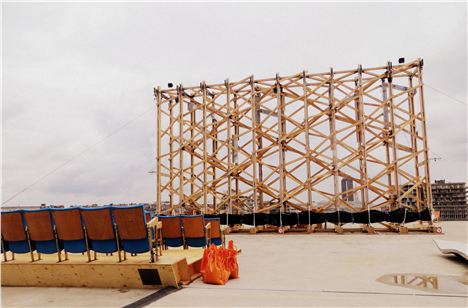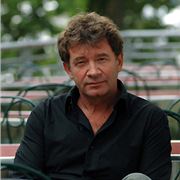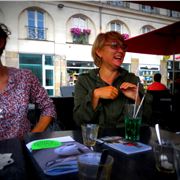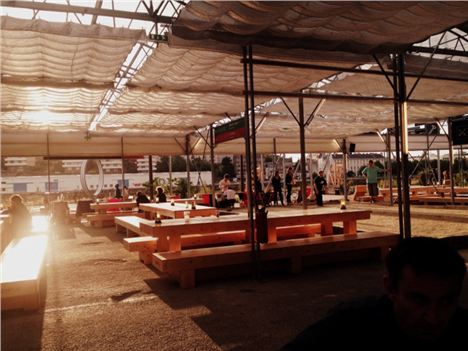IT'S the best story Jules Verne never wrote.
Lured from Toulouse by a man with a plan, to disused dockland sheds, they travelled light to this dying port city by the Atlantic.
With a one-way ticket and only one possession: the pollen of imagination.
Once there, they cast it on the westerly breeze, and it germinated with dormant seeds of like minds already on the ground.
There are new places to socialise, eat and drink, because they know that’s how to reel you in
New shapes were formed. Designers fused with technicians, artists and musicians. From their unions were born mechanical spiders, a Sultan’s Elephant and other fantastical creatures. Some said there were even giants.
And then to foreign lands they roamed, catching the dreams of the gaping people. To an incessant rock n roll beat, they performed woven, bespoke stories. They earned applause for their masters - not to mention pounds, dollars and euros by the million. Heavy baggage, with a more tangible value to haul home.
As for the man with the plan, he became ruler of the whole land.
Twenty-five years after that colonisation by Jean Luc Courcoult and Royal de Luxe (the grandiose street theatre company he formed in that shed) Nantes, birthplace of Jules Verne, is a city on a giddying cultural up.
Right now, and until the end of August, art and the people who make it are oozing from this city’s pores.
Its magnifying mirror is Le Voyage a Nantes. This is two things: it is the name of the city’s annual summertime mega-festival and it is the name of the public company in charge of both culture and tourism - the city’s hottest properties.
Elitist it isn’t. Butchers, bakers, bartenders, gardeners, the 100 best restaurants in the Loire Atlantique department; all are actively involved, whether it is making special cakes and chocolates for the duration of the festival, fashioning the hedgerows of the local botanical gardens into fabulous snakes and chicks, or merely hanging a surreal piece of artwork over the doorway of the local barbers.
Le Voyage a Nantes is a party to which everyone is invited - and everyone is obliged to turn up.
The idea is that you follow a green line under your feet and drift along a 10-mile trail, with 30 stops. You will encounter Patricia Buck’s random football cage in a side street, open all day for a kickaround. Over there, a colossal wooden climbing frame shaped like a dragon, which would be immediately shut down by health and safety inspectors back home.
The roof of the new National Architecture School has been turned into an outdoor cinema, complete with deck chairs, a bar and a 100ft screen. You might go there for beer, but you will end up watching a film.
 The cinema on the roof of the National School of Architecture
The cinema on the roof of the National School of Architecture
Yet this July-August event has not been without Anoosh Kapoors and his ilk. The big names don’t say non to Nantes.
Down in one of the city’s many permanent communal barbecue areas, someone has installed a ball pool into which you can be buried up to your neck. Le Voyage a Nantes strikes at the heart of public spaces, squares, parks and gardens. Houses about to be demolished become vivid galleries. There is singing, dancing, playing.
Best of all, there are new places to socialise, eat and drink, because at Le Voyage a Nantes they know that’s how to reel you in.
 David Moinard, artistic director
David Moinard, artistic director
We are in an agreeable back-street restaurant called La Raffinerie. It is a sleepy Monday lunchtime and David Moinard is talking about how the hottest, wildest creative places are eventually tamed by the carefully manicured hand of the bourgeoisie - and how to stay ahead of the game. He is an important figure in the next chapter of Nantes’ renaissance, and gets to go around the world seeking out the best artists that French government and municipal money can buy.
He is the artistic director of Voyage a Nantes and L’Estuaire, its summer-long child, now in its fourth incarnation. Both events opened two days earlier and L’Estuaire has obviously gone down well: people are coming up to congratulate Moniard, to shake his hand.
L’Estuaire’s “gallery” is 30km long, stretching along the banks of Loire from Nantes until it spills into the ocean at Saint Nazaire.
At every meander the landscape diverts: oil refineries and rusting docks one minute, cool Monet glades and lazy cycle trails the next. 
Playing away from home: Jean Luc Courcoult does stuff other than giants
Surprise after artistic surprise is its punctuation, some old L’Estuarie commissions, some new for 2014: an abandoned tilted house, half submerged in lonely waters, was created by Liverpool’s new best mate, RDL boss Monsieur Courcoult, in what he calls “imagined realism”.
Want to treat your loved one, or somebody else’s loved one? Spend the night in Villa Cheminee, artist Tatzu Nishi’s house, perched, with front garden, on top of a power plant chimney stack.
Down river at Saint Brevin Les Pins, a giant skeletal snake, Serpent d’Ocean, by Chinese artist Huang Yong Ping, is bathed and rinsed twice daily by the sure rhythms of the tide.
And Lunar Tree, a dead 40ft trunk of uncertain species, painted bone white by Mrzyk and Moriceau. Rising innocuously out of the landscape by day like some prehistoric limb, when viewed at night from a very specific point (under one of the Titan cranes guarding on Ile de Nantes), it shines like silver the inky darkness. Moon river.
“We don’t call this a biennial,” says Moinard. “We knew that every city wants its own biennial and we wanted to do something different. We wanted to make art in the public space, as this creates a very direct relationship with the people. So first we went outdoors.
“Also we wanted to create permanent works to sit alongside the temporary ones. And then we thought we would have a beginning and an end. So each of the L’Estuaire events are chapters in an ongoing story.”
L’Estuaire is, in fact, part of a much bigger story. Moinard is of the many protégés de l'enfant of a man called Jean Blaise who is revered in these parts.
Le Lieu Unique, a place for meddling
It was a much younger Moinard who came to Nantes in 2001, saw what Blaise was doing with a groundbreaking arts centre/nightclub called Le Lieu Unique, and became desperate to get what is now known as an internship. Anything to be part of the dance going on at the former Liu cracker factory that had sent his senses spinning on first sight.
In the delightfully rough English translation, Le Lieu Unique is described as “a place for meddling”.
Blaise, who grew up in Paris, has been meddling in Nantes - and with Nantes - since the dark times of the early 1980s. Like Liverpool, Nantes was a fallen port city built on the bloody and flawed mercantile promise that was slavery, only to be floored by containerisation.
Enter a socialist mayor, Jean-Marc Ayrault, first elected in 1989 and French Prime Minister until just three months ago. The paths of Ayrault, Blaise and Courcoult had already crossed elsewhere. A little older and wiser, but with eyes wide open, they drew a new map for Nantes: one where all economic roads led to arts and culture. It was a unique relationship between artists and politicians, say observers, built on complete trust.
 Jean Blaise - cultural
Jean Blaise - cultural
architect and 'ideas man'Blaise, artistic director for special events in Nantes and now director of tourism, is like an evangelist pastor to whom no one, seemingly, can say no - certainly not politicians who have given him megabucks to spend.
“Culture is never too expensive,” he insists.
Light Night, an event that takes place all over Europe every May; that was Blaise.
And that ugly office block over there, the one with the panoramic views over the city? It was Blaise who got them to open a bar on the roof and turn over its 360 degree balcony to the public. Forget expense-account exclusivity; there are playful installations and soft furnishings - designed by artists, many with children in mind.
I met Blaise a year ago in Salford’s Media City. The 64-year-old speaks little English and I had been asked to “facilitate” a breakfast meeting in which he addressed arts practitioners in the North West. It was a lot more interesting than I have just made it sound. The room, spellbound, had never heard the like.
Back on his own turf, Blaise is all action. He knows the people and the people him. You will find him in the restaurants and bars, but maybe not without a purpose.
His chat with the manager of the riverside brasserie, for example, who casually mentioned how they were opening a terrace, across the road, on the shore of the Loire. They were off to buy tables and chairs from a trade supplier. Blaise convinced them otherwise: far better to give the job, and the money, to an artist instead. The result is Canadienne, a wooden-teepee restaurant space, designed by a group called Collectif Fichtre. No one is in a hurry to pull it down when the festival is over.
 Artist Patricia BuckEven the hotels are in on the act. Artists have designed the rooms at several of them and Royal de Luxe’s Sultan’s Elephant is disconcertingly plastered onto the walls of mine at the mid-town Pommeraye. For some reason, the room next door is shrine to Lieutenant Columbo.
Artist Patricia BuckEven the hotels are in on the act. Artists have designed the rooms at several of them and Royal de Luxe’s Sultan’s Elephant is disconcertingly plastered onto the walls of mine at the mid-town Pommeraye. For some reason, the room next door is shrine to Lieutenant Columbo.
In the old warehouses of L'Ile de Nantes, which Royal de Luxe made their home in 1989, you can still marvel and gasp at the innovative work of Les Iles des Machines.
Created by two artists, François Delarozière, of La Machine (who brought the spider, La Princesse, to Liverpool in 2008), and Pierre Orefice, they visualise a travel-through-time world forging the imagination of Jules Verne and the mechanical universe of Leonardo da Vinci. One result, The Marine Worlds Carousel, is a wonder. Go for a spin when you get bored being sprayed by the trunk of the Sultan’s wooden elephant.
One cooling influence you can’t hold back forever is the tide of conventionality. Here on Ile de Nantes, once the artists’ Brave New World, confidence has grown to such a degree that even the Courts of Justice have moved to a brand new building there.
Meanwhile, young French spirits of invention, hearing the stories of Nantes’ reinvention, are relocating there in droves, eating and playing petanque at uber-trendy restaurants like Cantine - another Voyages a Nantes installation on the Ile, wouldn’t you know.
In what the Nantes marketing spiel calls “the creative metropole of dreams and fantasy” there may even be giants.
But even if there aren’t, nobody seems too fussed.
Why and how you should go
easyjet flies to Nantes from Liverpool daily from July 1 until September with prices starting from £26. Alternatively, Nantes is also served well by flybe from Manchester.Nantes is under an hour's drive from the Breton and Vendee beach resorts popular with British holidaymakers.
Angie Sammons stayed at the Pommeraye hotel in central Nantes/ Artists rooms at around £55 a night. Others even cheaper.
 Columbo curtains at
Columbo curtains at
the Pommeraye hotelStarting at just 17 Euros, a Nantes pass gives singles, couples and families unlimited travel on public transport and admittance to the city's top 30 attractions for one to three days. Admittance to museums and galleries is mostly free. They are open until 7pm every day throughout August.
There are plenty of vetted places to eat and drink listed in the citywide guide Table a Nantes
Greeters de Nantes will happily share their city and department with tourists for free.
Full info about Voyage a Nantes and L'Estuaire can be found here
The Nantes tourism website is here.
Follow Angie Sammons on Twitter @twangeee














